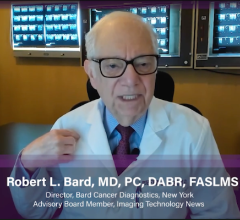
April 24, 2012 —ActiViews Inc. announced it has received U.S. Food and Drug Administration (FDA) 510(k) clearance to market its flagship product, CT-Guide Needle Guidance System, for liver interventions.
CT-Guide navigation is designed to assist physicians during computed tomography- (CT) guided interventional diagnostic and therapeutic procedures such as percutaneous biopsies, ablations and marker placements in the lung and liver. The system enables physicians to locate interventional instruments in relation to pre-acquired CT images, which is analogous to the way a GPS locates a car using stored roadmaps. CT-Guide navigation features a single-use miniature video camera that is easily affixed onto standard interventional instruments, a patented sterile registration sticker and proprietary 3-D software viewable on a high-definition (HD) flat panel monitor mounted on a mobile workstation. CT-Guide navigation allows physicians to determine the location of the navigated instrument in relation to the 3-D space of the CT images and the desired target, continuously displaying the location of the instrument and its planned path on the CT image of the patient’s anatomy.
“With [this] announcement, ActiViews further cements our commitment to become a leading provider of minimally invasive thoracic and abdominal surgical oncology solutions,” said Christopher von Jako, ActiViews president. “With now our second successful clinical trial for the FDA with CT-Guide navigation, we are able to offer our customers an expanded indication from lung into liver and further clinical evidence of the efficacy of our unique and simple tool in these critical applications.”
In support of its FDA medical device submission for liver interventions, ActiViews concluded a safety and effectiveness clinical trial in December at two hospitals affiliated with McGill University Health Center in Montreal, Canada. The clinical study yielded 100 percent success in the primary endpoint of targeting accuracy with CT-Guide navigation used in biopsy and radiofrequency and microwave ablation procedures, and there were no device-related adverse events.
"With our experience in over 150 procedures performed at our institution, we demonstrated that CT-Guide navigation is an ideal tool for various CT-guided interventional oncology applications. By being very easy-to-use and simple to learn, the ActiViews device enables even less experienced users to perform the procedures with the effectiveness and confidence of more advanced users, further enhancing the benefits of minimally invasive interventions to a wider range of patients," said David Valenti, assistant professor and head of the division of interventional radiology, McGill University Health Center, and principle investigator in the liver study.
"The simplicity and accuracy of the ActiViews system in guiding complex, deep and double angled needle approaches has been key in our adoption and repetitive usage in our minimally invasive interventional oncology procedures at McGill. Further, by eliminating most of the trial and error cycles involved in freehand guidance, the system has shown in some of our other preliminary comparative studies to shorten procedure time and reduce patient radiation exposure during the procedure," said Tatiana Cabrera, assistant professor of radiology, McGill University Health Center.
For more information: www.cancer.com, www.activiews.com


 November 11, 2025
November 11, 2025 









